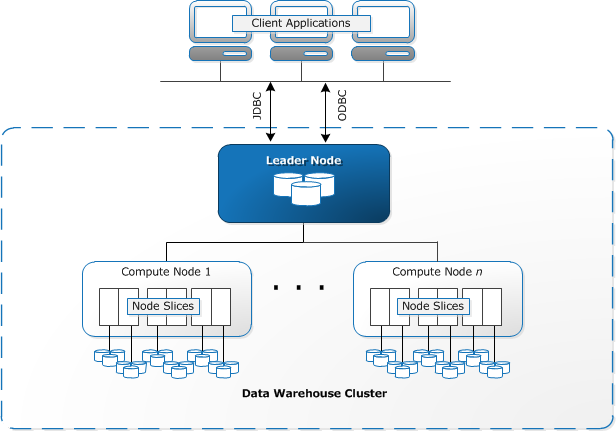
AWS Redshift vs. Snowflake: 5 Key Differences
The rise of big data has been met with a commiserate increase in data storage and computing technologies that can scale effectively without costing businesses an arm and a leg. The decision to build a cloud data warehouse on Redshift vs. Snowflake is often complex and involves several factors that must be considered. Cloud data warehouses are seemingly the perfect solution to cater to the increase in overall data volume as they allow businesses to create a unified view and run complex queries on large data sets.
According to a survey by Yellow Brick Data, 75% of organizations want to invest in data warehouses and lakes for better security, agility, and a streamlined business intelligence process.
If you are in the process of choosing a cloud data warehouse service, we have compared Snowflake Vs. Redshift—two leading cloud data warehouses in the market. Read ahead to discover the merits of both data warehouses and which suits your organization’s data analytics needs.
What is Snowflake?
Snowflake is a popular SQL cloud-based data warehouse built on Amazon Web Services or Microsoft Azure. What sets Snowflake apart from other options in the market is that you can scale computing and storage separately. This is useful in scenarios with a sudden spike in data processing needs. For example, when a company runs a new marketing campaign or during the final round of voting on a popular reality TV show.
You can integrate Snowflake with other analytical tools and backend enterprise applications to perform complex queries on your data. Let’s understand how Snowflake integration works and what its architecture looks like.
The cloud data warehouse comprises three layers:
- Storage Layer: This layer, like a mailroom, stores all incoming data. It is responsible for organizing and tracking all data. To ensure efficient retrieval, it stores data in micro partitions. Usually, data lies in a cloud storage layer such as Amazon S3 or Azure Blob Storage. The storage layer compresses data and records metadata.
- Query processing: This is a computing layer through which you can analyze data by requesting it. This layer has multiple virtual warehouses that are a cluster of computing resources. Each virtual warehouse has a dedicated computing capacity that doesn’t compete with another warehouse. The querying layer also has a cache system, which stores frequently accessed queries.
- Cloud services: This is the top layer responsible for coordinating all activities in Snowflake. It supports infrastructure management, metadata management, authentication, access control, query parsing, and optimization.
When to use Snowflake?
If you are not using the AWS ecosystem, then Snowflake can be a viable solution. Although Snowflake does not seamlessly integrate with AWS products, it does support various analytical tools such as Power BI and Tableau.
Snowflake also provides more robust support for JSON storage. It is a better option for working with JSON due to built-in functions for querying and storing. It is a better option for working with data lakes and unstructured data.
Snowflake is also a viable option for agile DevOps teams with its support for dynamic data changes.
Since storage and computing are separate in Snowflake, it is best to get temporary high workloads to increase the total capacity without increasing storage.
Just like Redshift, Snowflake is also optimized for OLAP transactions.
What is AWS Redshift?
AWS Redshift is a column-based cloud data warehouse that can scale up to petabytes. A column-based system stores data sequentially, unlike a row-based system. The columnar storage system makes it easier to compress and retrieve data. The data warehouse is optimized for OLAP queries.
Amazon Redshift is based on Postgres SQL, so most SQL-based applications can seamlessly integrate with it. You can also easily integrate it with BI tools, third-party data integration tools, data mining, and analytical tools.

When you compare the architecture of Amazon Redshift architecture with Snowflake’s, there is a considerable difference between the two.
Amazon has a collection of computing resources called nodes, which store data. The nodes are organized as clusters, called Redshift clusters. Each cluster runs on an AWS engine. You can have up to 128 nodes. There is a Leader Node that manages all communication with all client programs.
AWS Redshift is super-fast regarding querying speeds because of its Massively Parallel Processing (MPP) design, which ensures clusters can work independently without affecting other clusters’ performance. Redshift also utilizes custom communication protocols to optimize node-to-node connectivity.
You can start small with AWS Redshift with a 160 GB node and then add nodes to leverage parallel processing.
Related: Top AWS ETL Tools in 2024.
When to use AWS Redshift?
AWS Redshift would be better if you already use AWS products since it seamlessly integrates with the AWS ecosystem. With Redshift, you can also leverage AWS analytical tools, as Redshift supports native connectivity. Redshift is also the better option when scaling humongous data (in petabytes).
The data warehouse is optimal for OLAP transactions, which means you can do analytical queries on large volumes of data. However, it lacks essential database modification functions such as insert, delete, or update required in OLTP data warehouses. If you are in the e-commerce business, for example, or you want a data warehouse for an airline or hotel booking website, Redshift might not be the best choice.
Now that we’ve briefly covered the best scenarios for using Redshift and Snowflake, it’s important to look at their features and use cases in more detail. This will help you make a more informed buying decision and choose the best DWH solution for your specific needs.
Redshift Vs. Snowflake: Pricing
A cost vs. benefit analysis is one of the best ways to determine the right choice before deciding between Redshift and Snowflake. Both data warehouses offer different pricing structures.
Snowflake works on the pay-as-you-go model. Snowflake has separate storage and compute costs. Storage is charged per terabyte, begins at a flat rate of $23/terabyte, and is accrued monthly. Compute pricing starts at $0.00056 per second, per credit, for On-Demand Standard Edition.
Depending on your usage, you can enable any virtual data warehouse for computing. Virtual data warehouses are available in 8 different sizes, and the smallest size costs one credit or $2 per hour. It does not charge you for any idle time.

Snowflake Virtual Data warehouses sizes
Initially, Snowflake’s On-Demand pricing model can be enticing, but in the long run, it can be very unpredictable, with costs increasing as usage increases.
Compared to Snowflake, Redshift has a simple pricing structure based on redshift clusters. The formula for Redshift On-Demand pricing is as follows:
Amazon Redshift Monthly Cost = [Price Per Hour] x [Cluster Size] x [Hours per Month]
Redshift also offers Reserved Instance Pricing, which allows you to unlock 75 percent savings. In a reserved instance, you pay a pre-defined amount whether a cluster is active or not. These expenses can be optimized in the long run using AWS cost management tools.
Verdict: Redshift is better overall pricing-wise.
Redshift vs. Snowflake: Performance and Integrations
Redshift integrates with other AWS services seamlessly, such as DynamoDB and CloudWatch. It also enables you to transfer data from Amazon S3 and Amazon’s other storage options with ease.
On the other hand, Snowflake supports integrations with the Apache suite and leading BI tools, like Qlik and Tableau.
Redshift requires correct key configurations for optimal performance. Setup inaccuracies can cause data storage and retrieval issues. Since setting the keys can be a hassle, Redshift can have a steep implementation curve. In terms of power, both software can run data analytics hundreds of times faster than source databases.
Verdict: here, the answer will depend on the specific integrations you require.
Redshift Vs. Snowflake: Security
The reality of our world is that data is your most important asset; hence, you cannot take any risks regarding security.
Both data warehouses take security seriously and offer various features that ensure your data is always protected.
AWS Redshift offers sign-in credentials, column-level access control, Access Management, cluster encryption, and SSL connections that keep your client and clusters private. You can also use client-side or server-side encryption to encrypt your data while uploading so it is not vulnerable during transit.
As far as Snowflake is concerned, it offers somewhat similar security features to Redshift. It gives you SCIM to manage user identities and groups. Key Pair Authentication, multi-factor authentication, and always-on authentication are also present alongside VPC/VPN. AES-256 encryption is rekeyed periodically and encrypts all stored data.
However, Snowflake’s security features vary with different product tiers.
Redshift also offers various security validations for compliance, including SOC 1 Type II and SOC 2 Type II. HIPAA, PCI DSS, HITRUST CSF, FedRAMP Moderate, and IRAP Protected compliance.
Verdict: Both solutions provide top-notch security.
Redshift Vs. Snowflake: Maintenance
Snowflake is the apparent winner compared to AWS Redshift in terms of maintenance because its separate storage and compute architecture makes it easier to scale up and down. You can change a warehouse’s size or increase the number of clusters. The best part about Snowflake is the auto-suspend and auto-resume feature, which lets you run the query, and once you are done using it, it scales down the warehouse, so you are not charged for it.
On the other hand, AWS Redshift requires you to send queries in a queue. With concurrency scaling, AWS Redshift automatically adds additional capacity in clusters. However, you must manage which queries are sent to concurreny scaling through WLM queues. Re-sizing operations can take hours in Redshift.
Verdict: Snowflake wins here.
Redshift Vs. Snowflake: Data Support
For a long time, Snowflake had the edge over Redshift because of Snowflake’s excellent support for semi-structured data, especially JSON.
However, Redshift quickly caught up, and in 2020, it introduced a new data type called SUPER that supports most semi-structured data, including JSON. SUPER is a generic data type that is schema-less.
It also introduced PartiQL, an extension of SQL that allows easy querying of semi-structured data.
Snowflake and Redshift also support other popular data formats, including XML, AVRO, Parquet, etc.
Verdict: tie. Both Snowflake and Redshift have robust data support features. Snowflake takes the slight edge due to better unstructured data support.
Redshift Vs. Snowflake: Which is the Right Data Warehouse for You?
There is no definitive answer to what data warehouse you should choose; it all depends on your organization’s data analysis needs and existing infrastructures.
Here are the summarized benefits of choosing each option:
Benefits of Using AWS Redshift
- Since Redshift is based on AWS infrastructure, it seamlessly integrates with AWS services. You can use any third-party tools if you don’t want to use AWS services.
- AWS Redshift offers superior performance compared to other options in the market due to MPP technology.
- The cloud data warehouse has robust security protocols, including access management, SSL encryption for data, column-level access control, and client-side and server-side data encryption.
- Redshift is a fully managed platform and requires minimal monitoring and maintenance.
Benefits of Using Snowflake
- Businesses that see temporary spikes in traffic do not need to invest in hardware, software, or maintenance since Snowflake scales computing separately.
- Since Snowflake integration automatically optimizes data storage, you can easily combine structured and unstructured data.
- You can create accounts from Snowflake’s interface for seamless data sharing with other Snowflake users or external customers.
- The cloud data warehouse is suitable for a business with many users since each virtual warehouse scales up and down independently without affecting other queries.
- Snowflake offers extensive security features such as multi-factor authentication, OAuth, and Federated federated authentication. Plus, you can store data in multiple regions for higher availability.
Read our ranking of the 7 best Snowflake ETL tools.
ETL your Data Faster with Astera Centerprise
The decision of Redshift Vs. Snowflake is on you. Astera Centerprise can help you get started with your data warehouse solution without any hassle, regardless of which cloud data warehouse you choose.
Astera Centerprise is a code-free, cost-effective data platform with powerful ETL/ELT capabilities. It can load data from various sources in your data warehouse.
Astera Centerprise supports native connectivity to Snowflake and AWS Redshift. With Centerprise, you can extract and deliver data from various sources, including popular databases, cloud storage, and file formats such as JSON, XML, and Delimited to your data warehouse in minutes.
The code-free data integration platform lets you enrich your data with built-in transformations. You can use it to transform data and validate it to eliminate any redundancies, inaccuracies, and formatting errors before sending it to your destination.
Astera Centerprise can help you ETL your data faster into the data warehouse of your choice, so you can start taking advantage of the scalability, agility, and power offered by these powerhouse platforms.
Download Astera Centerprise today to seamlessly transfer data to your cloud data warehouse without writing a single line of code!
 Astera AI Agent Builder - First Look Coming Soon!
Astera AI Agent Builder - First Look Coming Soon!



